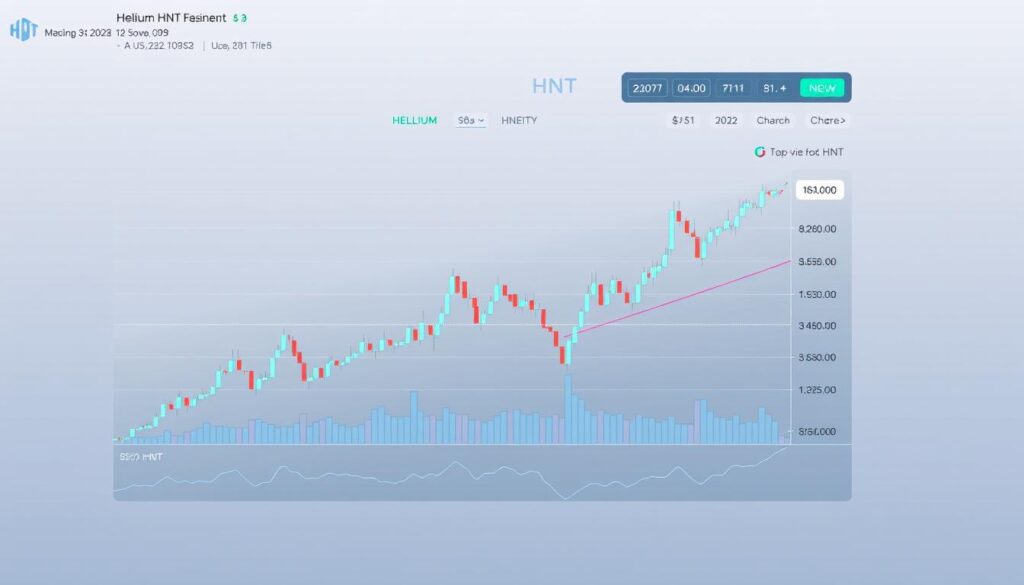Exploring Helium (HNT): The Decentralized Wireless Network Coin
In Mexico, over 2.3 million subscribers use Helium’s Hotspots for mobile data, thanks to a partnership with Movistar. This shows Helium’s goal to change wireless networks by giving control to users. The HNT token powers Helium’s network, which includes IoT and Mobile, reaching billions of devices worldwide.
Helium changes how we think about wireless networks. Instead of big towers, anyone can host a hotspot and earn HNT. This model has low fees, like $0.35 per transaction, unlike Solana’s $0.00025. With almost a million hotspots in 77,000 towns, Helium is the largest LoRaWAN network, showing decentralized networks can compete with giants.
Key Takeaways
- Helium’s IoT and Mobile networks serve 100,000+ devices and 2.3M Mexican users via Movistar.
- Users earn HNT by deploying hotspots, while HNT must be burned to buy Data Credits for network access.
- Over 192 countries host Helium’s infrastructure, making it the largest LoRaWAN globally.
- Companies like Roof Tec slashed costs by $40,000 using Helium’s IoT, showing real savings.
- Helium Mobile’s $20/month unlimited plans challenge traditional telecom pricing models.
What is Helium (HNT) and Its Revolutionary Approach to Wireless Networks
Helium (HNT) combines blockchain tech with real-world infrastructure for IoT connectivity. Its Helium network uses a decentralized blockchain to create a global wireless system. This system supports devices like sensors and wearables. Founded in 2013, Helium blends open-source innovation with economic incentives for contributors.
The Origins and Vision Behind Helium
Amir Haleem, Shawn Fanning, and Sean Carey wanted a wireless network free from corporate control. They aimed to create a community-owned system where users earn rewards for expanding coverage. The Helium blockchain ensures transparency, tracking hotspot contributions and payouts.
Helium’s Unique Position in the Cryptocurrency Landscape
Helium’s HNT is different from other cryptocurrencies because it has direct utility. Key differences include:
- Physical infrastructure: Hotspots validate coverage, not just mine blocks
- Fixed token cap: 223 million HNT total supply
- Real-world data: Over 462,000 active hotspots globally
The Evolution of Helium From Its Launch
Key milestones in the Helium network:
| Year | Event |
|---|---|
| 2013 | Project founded by core team |
| 2019 | Helium Hotspot launched; blockchain mainnet activation |
| 2023 | Migrated to Solana blockchain for scalability improvements |
| 2024 | Over 462,000 hotspots deployed worldwide |
Today, the network reaches areas traditional networks can’t. It covers 80% of hotspots operational at any time. This growth shows Helium’s shift from a cryptocurrency experiment to a critical IoT backbone.
The Problem Helium Solves: Bridging IoT Connectivity Gaps

Traditional wireless networks struggle to meet the growing demand for IoT connectivity. Centralized providers face high costs, limited coverage in rural areas, and slow expansion. This creates gaps where devices can’t reliably connect—mostly in underserved regions.
- High infrastructure costs: Deploying cellular towers or fiber cables often costs thousands per household, as seen in Nebraska’s $50,000 fiber installation per home.
- Uneven coverage: Rural and remote areas lack affordable options, leaving devices offline.
- Scalability limits: Cellular networks can’t efficiently handle millions of IoT devices due to pricing and capacity constraints.
The Helium token economy reimagines this model. It rewards users who deploy Hotspots—hardware nodes that expand coverage. This turns anyone into a network contributor. Each Hotspot validates coverage and earns HNT tokens, reducing reliance on expensive centralized infrastructure.
This crowdsourced approach cuts costs dramatically. For example, Miami’s $5 unlimited Helium Mobile plans are much cheaper than traditional cellular rates.
Over 320,000 Hotspots worldwide prove the model’s reach. In Colorado, communities like Boulder are adding 50+ Hotspots to extend coverage. The Helium token’s incentive system aligns users’ interests with network growth, creating a self-sustaining IoT backbone. With LoRaWAN support and Solana’s efficiency upgrades, the network scales while lowering costs for sensors and smart devices.
By decentralizing infrastructure costs, the Helium token bridges gaps in IoT connectivity. It empowers underserved regions and businesses with affordable, expansive coverage.
Understanding the Technical Foundation of the Helium Network
The Helium Network is built on three key parts: its consensus mechanism, blockchain architecture, and token model. These ensure security, scalability, and fairness.
Proof of Coverage: Helium’s Novel Consensus Mechanism
Helium hotspots prove their location and coverage with Proof of Coverage (PoC). They receive random challenges that test their physical presence and signal range. This collaboration with other nodes prevents cheating and ensures reliable wireless coverage.
The Helium Blockchain Architecture
Helium moved to the Solana blockchain for faster transactions and lower fees. Its architecture includes:
- SubDAO frameworks for IoT and mobile networks, allowing specialized governance
- Decentralized data validation through PoC and blockchain consensus
This setup supports millions of IoT devices while keeping security high.
HNT Tokenomics and Distribution Model
The HNT token supply is capped at 223 million. Hotspot owners get rewards for validating coverage and storing data. The token’s value changes with HNT price fluctuations, driven by Data Credit demand.
Halving events reduce inflation, encouraging long-term participation. This combination of systems makes Helium hotspots and the HNT token useful and innovative, driving growth.
Helium Mining: Building the People’s Network

Helium mining lets people help build a decentralized IoT network. They do this by setting up hotspot devices. By doing so, they earn cryptocurrency rewards for validating data and expanding the network’s reach. There are two main types of hotspots.
Types of Helium Hotspots and Their Functionality
There are two main types of Helium hotspots:
- LoRaWAN Hotspots: These connect IoT sensors for low-power devices like smart meters.
- CBRS Hotspots: These enable mobile broadband via shared spectrum, supporting cellular devices.
The Helium Mining Process Explained
To start mining, follow these steps:
- Deploy hardware with GPS verification to confirm location
- Participate in network validation through data challenge/response tests
- Receive rewards based on coverage contributions
Hotspots must pass “proof of coverage” by being witnessed by other nodes. This confirms their position. Over 70,000 hotspots were blacklisted for suspected cheating in 2021.
Reward Structure and Earning Capacity
Rewards depend on how much you participate in the network. Here’s what history shows:
| Year | Total Mined | Monthly Earnings |
|---|---|---|
| 2019 | 3.5M HNT in 3 months | 33,000 HNT/month |
| 2023 | N/A | ~2 HNT/month |
“Over 100,000 hotspots now exist, but earnings have plummeted from peak levels,” reported industry analysts.
Revenue comes from data transmission fees and token rewards. But now, hotspot owners earn as little as $0.10 monthly. Token halving every two years also cuts reward rates. The SEC has accused Helium of inflating partnerships, which has shaken trust in reward projections.
Setting Up Your First Helium Hotspot: Requirements and Considerations
Starting with a Helium hotspot means picking the right hardware. Options like the Bobber 500 ($999, 500m range) or Bobcat 300 ($429, 300m range) differ in cost and range. It’s key to place the antenna on a rooftop at least 20ft high to get the best signal.
Keep the cable between the hotspot and antenna under 5ft to avoid signal loss.
- Hardware: Choose from 13+ certified models (e.g., Mimiq FinestraMiner at $600)
- Power: Uses 5-15W (equivalent to a router)
- Data usage: 100-150GB/month
| Model | Price | Max Range |
|---|---|---|
| MNTD Blackspot | $500 | 300m |
| SyncroB.it Gateway | $650 | 500m |
| SenseCAP M1 | $519 | 200m |
For the best signal, place the antenna high up. A 120ft antenna can boost your signal 8-10 times compared to ground level. Use good cables to keep your signal strong.
Sign up on the Helium app, then add HNT tokens to start. After May 11, Light Hotspot software will cut down on data usage.
Check your earnings on the Helium app dashboard. Early starters in less crowded areas might earn more, but it’s getting competitive. Antennas with 3-6dBi gain offer good performance. The initial cost is $300-$900, and you might earn $200-$500 a month, based on Australian data.
HNT Price Analysis and Market Performance

HNT price has seen big ups and downs. In November 2021, it reached an all-time high of $49.69. Now, it trades around $3.39, with a market cap of $892 million. Over the past year, volatility averaged 7%, showing how it reacts to big events.
Historical Movements
Recently, HNT price went up 15% in a month. But, it dropped 49% from its 2021 highs. The number of tokens in circulation affects its price. It has a 12% weekly gain, but monthly losses are seen.
Influencing Factors
- Network adoption: Over 1 million hotspots drive utility demand.
- Token utility: Data Credits burned for IoT use cases tie HNT price to real-world usage.
- Market sentiment: 29% bullish forecasts contrast with 46 Fear & Greed Index scores.
Market Comparisons
Compared to IOTA and CHZ, HNT’s $4.20 2025 average price prediction trails IOTA’s $1.20 but aligns with its infrastructure focus. Long-term forecasts suggest a 216% ROI by 2027, driven by IoT partnerships and hotspot growth.
Investors tracking HNT price should watch hotspot adoption rates and enterprise deals. These factors directly affect its value.
The Growing Helium Ecosystem: Partners and Integrations
The Helium network has grown thanks to partnerships like Movistar’s. They connected 2.3 million subscribers in Mexico to mobile data. This shows the
Microsoft Azure users can now use Helium network for IoT devices. This means they don’t need to build out infrastructure. With 719,000 global hotspots in 54,000 cities, it’s a big deal.
Companies like DISH and Cisco are working on smart city and logistics apps. They’re making the network’s uses go beyond just crypto.
- Carrier partnerships: DISH, Senet, and Actility serve clients like Volvo and Schneider Electric
- Q4 milestones: 576 TB of offloaded data (555% increase) and 124,000 Helium Mobile subscribers
- Hotspot growth: 24,800 mobile nodes and 32,900 IoT hotspots post-Solana migration
DAWN is teaming up with Starlink to add 8,000 new hotspots. They’re focusing on rural areas. The $5 unlimited plan in Miami and Broward/Palm Beach shows Helium network’s move into consumer markets.
With Solana upgrades, the ecosystem now supports cross-chain apps. This is attracting developers and businesses.
These partnerships are making the Helium network a strong choice for IoT and connectivity. As more integrations happen, the ecosystem’s value grows for everyone involved.
Real-World Applications Powered by Helium’s Wireless Network
Helium cryptocurrency is driving innovation in many fields. It turns decentralized wireless tech into real solutions. From city planning to farming, it helps devices save money and work better. This shows how blockchain can do more than just digital deals.
Smart City Infrastructure
City planners use Helium hotspots to make cities smarter. Roof Tec in Washington uses the network to watch over bridges and roads. This keeps everyone safe.
Sensors track air quality, traffic, and waste bin levels. This lets smaller cities get smart tech without huge budgets.
Agricultural and Environmental Solutions
In Portugal, Greenmetrics cut golf course water use by 28% with Helium sensors. Farmers can now check soil moisture, weather, and wildlife habitats. This helps them care for their land better.
| Company | Use Case | Water Saved |
|---|---|---|
| Greenmetrics | Golf Irrigation | 14–28% |
Transportation and Logistics
Owen Equipment, a big logistics company, saved 47% with Helium. They track assets, find supply chain delays, and manage fleets better. This makes their work more efficient and cost-effective.
| Company | Industry | Cost Reduction |
|---|---|---|
| Owen Equipment | Transportation | 47% |
Challenges and Limitations Facing the Helium Network
The Helium blockchain has faced technical challenges. Its original design struggled to grow fast. Moving to Solana in 2023 helped but raised questions about long-term stability.
Today, over 1 million hotspots operate worldwide. But, they are not evenly spread. Urban areas have too many, while rural areas have too few.
Earning enough money is a big worry. Cutting rewards made it harder for hotspot owners to make money. HNT’s price fell from $53 in 2021 to $9.20 in 2022, making investors unsure.
Trying to fix this, HIP 138 aims to make things better. But, the new system’s future under strict rules is uncertain.
Rules for wireless networks vary worldwide. This makes it hard to grow. In some places, hotspot owners are unsure about using the airwaves legally.
Big companies control the hardware, and a few hold most of the tokens. This could lead to unfair control.
- 124,000 mobile users use the network. But, making it easy for everyone to use is key.
- The network handled 576 TB of data in Q4 2024. But, it might get too busy during peak times.
The Helium community is working hard to solve these problems. They use HIPs and partnerships to improve. But, finding a balance between being open, growing, and following rules is a big challenge.
The Helium blockchain’s future is important. It could play a big role in the $1.6 trillion telecom market. But, it must first overcome these big challenges.
Conclusion: The Future Prospects of Helium in the Decentralized Wireless Landscape
Helium has changed how we think about wireless networks. It has over 1 million hotspots worldwide and a market value over $769 million. By 2025, it plans to double its hotspots, showing fast growth.
Starting in 2023, Helium made mining easier with Light Hotspots. This move makes it a leader in decentralized networks. It’s not just for IoT anymore but for many other uses too.
Innovation will drive Helium’s future. Adding Wi-Fi and new wireless tech could open up new services. Working with big telecoms could also help it grow faster.
But, there are challenges. Rules about spectrum use and too many hotspots in cities might hurt profits. Yet, rural areas could be very profitable because there’s less competition.
Helium uses very little energy, just 5 watts per hotspot. This is a big plus as people care more about saving energy.
Market trends show ups and downs. HNT’s price jumped 82.8% in a week, showing people are interested. But, it also fell 90% from 2021, showing crypto’s risks.
Choosing the right places for hotspots and getting involved in governance are key. Halving events in 2025 will reduce tokens, but Binance and Coinbase listings keep things liquid. Making money will depend on finding new ways to earn, like Data Credits.
Helium has shown decentralized networks can grow big. It has users and partnerships with big names like T-Mobile. It’s a challenge to traditional telecoms.
While there are risks, Helium’s growth shows it’s strong. Users need to keep innovating and solving real problems. This way, Helium can keep being a key part of decentralized networks.




